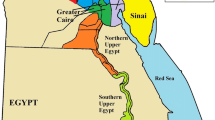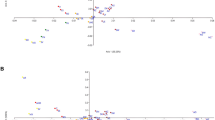Abstract
Pakistan is located at an important cross-road of human history and has been a passageway for many invaders and dynasties in the past. The historic human migrations across this country have resulted in a blend of ancient civilizations, which are still reflected in the current socio-cultural fabrication of this population. This makes Pakistan an ideal country to study the genetic differentiation and various other genomic aspects of a human population.
Similar content being viewed by others
References
Goudet J (2005) Hierfstat a package for r to compute and test hierarchical F-statistics. Mol Ecol Notes 5(1p):184–186. https://doi.org/10.1111/j.1471-8286.2004.00828.x
Rousset F (2008) Genepop’007: a complete re-implementation of the genepop software for Windows and Linux. Mol Ecol Resour 8(1p):103–106. https://doi.org/10.1111/j.1471-8286.2007.01931.x
Tereba A (1999) Tools for analysis of population statistics, profiles in DNA. Promega Corporation 2:14–16
Takezaki N, Nei M, Tamura K (2009) POPTREE2: software for constructing population trees from allele frequency data and computing other population statistics with Windows Interface. Molecular Biology Evolution 27(4p):747–752. https://doi.org/10.1093/molbev/msp312
Di Cristofaro J, Buhler S, Temori SA, Chiaroni J (2012) Genetic data of 15 STR loci in five populations from Afghanistan. Forensic Sci Int: Genetics 6(1p):e44–e45. https://doi.org/10.1016/j.fsigen.2011.03.004
Shepard EM, Herrera RJ (2006) Iranian STR variation at the fringes of biogeographical demarcation. Forensic Sci Int 158:140–148. https://doi.org/10.1016/j.forsciint.2005.05.012
Dong L, Liu XX, Zhang HH, Bo R, Wei G, Zhang LS (2010) Genetic data for 15 STR loci in Uygur ethnic group of Northwest China. Romanian J Legal Med 18(1). https://doi.org/10.4323/rjlm.2010.59
KraaijenbrinK T, VAN Driem GL, Opgenort JRML, Tuladhar NM, DE Knijff P (2007) Allele frequency distribution for 21 autosomal STR loci in Nepal. Forensic Sci Int 168, no. 2-3p:227–231. https://doi.org/10.1016/j.forsciint.2006.02.014
Kraaijenbrink T, Driem V, George L, Gaselô OF, Tshering K, De Knijff P (2007) Allele frequency distribution for 21 autosomal STR loci in Bhutan. Forensic Sci Int 170(1p):68–72. https://doi.org/10.1016/j.forsciint.2006.04.006
Garcia-Bertrand R, Simms TM, Cadenas AM, Herrera RJ (2014) United Arab Emirates: phylogenetic relationships and ancestral populations. Gene 533(1p):411–419. https://doi.org/10.1016/j.gene.2013.09.092
Ghosh T, Kalpana D, Mukerjee S, Mukherjee M, Sharma AK, Nath S, Rathod VR, Thakar MK, Jha GN (2011) Genetic diversity of autosomal STRs in eleven populations of India. Forensic Sc Int Genetics 5(3p):259–261. https://doi.org/10.1016/j.fsigen.2010.01.005
Chaudhari RR, Dahiya MS (2014) Genetic diversity of 15 autosomal short tandem repeats loci using the AmpFLSTR Identifiler kit in a Bhil Tribe population from Gujarat state India. Indian Human Genetics 20:148–152. https://doi.org/10.4103/0971-6866.142879
Mohapatra, B. K., Kamal Chauhan, U. S., Thakur, Bhuvnesh Yadav and Anupuma Raina. Genetic analysis and evolutionary relationship of Jammu and Kashmir Muslim population with short tandem repeat loci. Int J Current Res 2016. Vol. 8, p. 36398–36401
NOOR S, ALI S, EAASWARKHANTH M, HAQUE I (2009) Allele frequency distribution for 15 autosomal STR loci in Afridi Pathan population of Uttar Pradesh, India. Legal Med 11(6p):308–311. https://doi.org/10.1016/j.legalmed.2009.08.002
CHISHTI HM, MANICA A, ANSAR M, ERIKSSON A, AJMAL M, HAMEED A (2016) Inability of the most commonly used forensic genetic markers to distinguish between samples belonging to different ethnicities of Pakistan with diverse genetic background. Forensic Sci Int: Genetics 22:e7–e8. https://doi.org/10.1016/j.fsigen.2016.01.006
Funding
The authors are thankful for the financial support provided by the Swiss Government Excellence Scholarship for PhD studies of foreign students in Switzerland and by the Centre for Applied Molecular Biology, University of the Punjab, Lahore Pakistan.
Author information
Authors and Affiliations
Corresponding author
Ethics declarations
Conflict of interest
The authors declare that they have no conflict of interest.
Rights and permissions
About this article
Cite this article
Anwar, I., Hussain, S., Rehman, A.U. et al. Genetic variation among the major Pakistani populations based on 15 autosomal STR markers. Int J Legal Med 133, 1037–1038 (2019). https://doi.org/10.1007/s00414-018-1951-0
Received:
Accepted:
Published:
Issue Date:
DOI: https://doi.org/10.1007/s00414-018-1951-0




